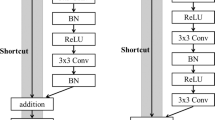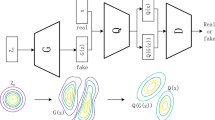Abstract
Generative Adversarial Networks (GANs) provide a novel way to learn disentangled representations. However, it is still challenging for them to generate convincing images. In this paper we introduce a novel Adversarial-Boundary Staged Generative Adversarial Networks (ABS-GAN) to generate more realistic images. ABS-GAN improves image quality from two aspects. On one hand, the complete training process is separated into two stages. The Stage-I generator is trained for decreasing the Earth-Mover distance between real and generated distributions. The Stage-II generator aims at explicitly reducing the distance further based on the Stage-I generator. On the other hand, the discriminator is treated as a projector from image to scalar. The discriminator tries to make the boundary between real and generated distributions clear in scalar space. Thus the generator synthesizes more realistic images, thanks to the extra adversarial boundary information. We conduct experiments on real-world datasets (CIFAR-10, STL-10, CelebA) to show the performance of our ABS-GAN. Comparisons with baseline model on benchmark datasets demonstrate that the proposed method achieves excellent improvement in producing convincing images in a simple way.
Access this chapter
Tax calculation will be finalised at checkout
Purchases are for personal use only
Similar content being viewed by others
References
Arjovsky, M., Bottou, L.: Towards principled methods for training generative adversarial networks (2017)
Arjovsky, M., Chintala, S., Bottou, L.: Wasserstein GAN (2017)
Coates, A., Ng, A.Y., Lee, H.: An analysis of single-layer networks in unsupervised feature learning. J. Mach. Learn. Res. 15, 215–223 (2011)
Ghosh, A., Kulharia, V., Namboodiri, V., Torr, P.H.S., Dokania, P.K.: Multi-agent diverse generative adversarial networks (2017)
Goodfellow, I.J., et al.: Generative adversarial networks. In: Advances in Neural Information Processing Systems, vol. 3, pp. 2672–2680 (2014)
Gulrajani, I., Ahmed, F., Arjovsky, M., Dumoulin, V., Courville, A.: Improved training of Wasserstein GANs (2017)
He, K., Zhang, X., Ren, S., Sun, J.: Deep residual learning for image recognition, pp. 770–778 (2015)
Huang, R., Zhang, S., Li, T., He, R.: Beyond face rotation: global and local perception GAN for photorealistic and identity preserving frontal view synthesis, pp. 2458–2467 (2017)
Kingma, D., Ba, J.: Adam: a method for stochastic optimization. Computer Science (2014)
Krizhevsky, A.: Learning multiple layers of features from tiny images (2009)
Liu, Z., Luo, P., Wang, X., Tang, X.: Deep learning face attributes in the wild, pp. 3730–3738 (2014)
Mirza, M., Osindero, S.: Conditional generative adversarial nets. Computer Science, pp. 2672–2680 (2014)
Odena, A., Olah, C., Shlens, J.: Conditional image synthesis with auxiliary classifier GANs (2016)
Petzka, H., Fischer, A., Lukovnicov, D.: On the regularization of Wasserstein GANs (2017)
Radford, A., Metz, L., Chintala, S.: Unsupervised representation learning with deep convolutional generative adversarial networks. Computer Science (2015)
Reed, S., Akata, Z., Yan, X., Logeswaran, L., Schiele, B., Lee, H.: Generative adversarial text to image synthesis, pp. 1060–1069 (2016)
Russakovsky, O., et al.: Imagenet large scale visual recognition challenge. Int. J. Comput. Vis. 115(3), 211–252 (2015)
Salimans, T., Goodfellow, I., Zaremba, W., Cheung, V., Radford, A., Chen, X.: Improved techniques for training GANs (2016)
Simonyan, K., Zisserman, A.: Very deep convolutional networks for large-scale image recognition. Computer Science (2014)
Szegedy, C., et al.: Going deeper with convolutions, pp. 1–9 (2014)
Tu, D.N., Le, T., Vu, H., Phung, D.: Dual discriminator generative adversarial nets (2017)
Wang, J., et al.: IRGAN: a minimax game for unifying generative and discriminative information retrieval models (2017)
Warde-Farley, D., Bengio, Y.: Improving generative adversarial networks with denoising feature matching (2016)
Yu, L., Zhang, W., Wang, J., Yu, Y.: SeqGAN: sequence generative adversarial nets with policy gradient (2016)
Zhang, H., et al.: StackGAN: text to photo-realistic image synthesis with stacked generative adversarial networks, pp. 5908–5916 (2016)
Zhu, J.Y., Park, T., Isola, P., Efros, A.A.: Unpaired image-to-image translation using cycle-consistent adversarial networks, pp. 2242–2251 (2017)
Acknowledgments
This work was supported by National Key Research and Development Program of China (Grant No. 2016YFB1000902), National Program on Key Basic Research Project (973 Program, Grant No. 2013CB329600), and National Natural Science Foundation of China (Grant No. 61472040).
Author information
Authors and Affiliations
Corresponding author
Editor information
Editors and Affiliations
Rights and permissions
Copyright information
© 2018 Springer Nature Switzerland AG
About this paper
Cite this paper
Li, Z., Song, D., Liao, L. (2018). Staged Generative Adversarial Networks with Adversarial-Boundary. In: Geng, X., Kang, BH. (eds) PRICAI 2018: Trends in Artificial Intelligence. PRICAI 2018. Lecture Notes in Computer Science(), vol 11012. Springer, Cham. https://doi.org/10.1007/978-3-319-97304-3_63
Download citation
DOI: https://doi.org/10.1007/978-3-319-97304-3_63
Published:
Publisher Name: Springer, Cham
Print ISBN: 978-3-319-97303-6
Online ISBN: 978-3-319-97304-3
eBook Packages: Computer ScienceComputer Science (R0)




